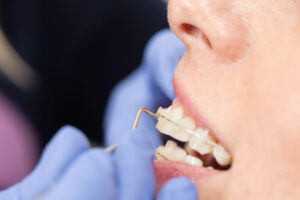How Much Do Braces Cost: Average cost of Braces Explained

What Is the Average Cost of Braces with Insurance?
Factors affecting the cost of braces with insurance
- Your Insurance Coverage: The most significant factor is your specific insurance plan. Some plans cover a percentage of orthodontic treatment, usually around 50%. However, many policies don’t cover braces for adults. Additionally, there’s typically a lifetime maximum benefit, which is the total amount your insurance will pay towards braces. These maximums often range from $1,000 to $2,000.
- Type of Braces: Traditional metal braces are the most affordable, while lingual braces (placed behind the teeth) are the most expensive. Your chosen type of braces will significantly impact your total cost and how much insurance contributes.
- Location: The cost of orthodontic treatment varies across different regions within the United States.
- Severity of Your Case: Complex orthodontic issues that require longer treatment will naturally be more expensive than simpler cases.
What to Expect: Out-of-Pocket Costs
Even with insurance, you’ll likely have some out-of-pocket costs for braces. Generally, you could expect to pay anywhere from $1,500 to $5,000.
Finding Out Your Costs
The best way to determine your specific costs is to:
- Contact Your Insurance Company: Find out if they cover orthodontic treatment, what percentage is covered, and if there are any lifetime maximum benefits.
- Consult an Orthodontist: Get a detailed quote from an orthodontist. They can often estimate how much your insurance might cover, leaving you with a better understanding of your out-of-pocket expenses.
How Much are Braces Without Insurance?
If you’re considering braces but don’t have dental insurance, you do need to know how much do braces cost. Let’s break down the factors affecting the price and what you might expect to pay.
Factors Influencing the Cost of Braces Without Insurance
- Type of Braces: Here’s a general price guide:
- Traditional Braces: The most affordable option, typically ranging from $3,000 – $7,000.
- Ceramic Braces: Offer a more discreet look and cost $4,000 – $8,000, but are more expensive than traditional braces.
- Lingual (Hidden) Braces: The most expensive option, ranging from $8,000 – $10,000.
- Location: Orthodontic treatment costs can vary depending on where you live. Urban areas are often more expensive.
- Severity of Your Case: Complex orthodontic issues requiring extended treatment will naturally cost more than minor adjustments.
- Orthodontist’s Fees: Experienced orthodontists might charge a premium for their services.
What to Expect: Total Costs
Without insurance, you’ll be responsible to pay for braces out of pocket. It’s best to be prepared for a total cost within the ranges mentioned above, depending on the factors involved.
Ways to Manage the Cost
- Payment Plans: Many orthodontic offices offer flexible payment plans to spread the cost over time, so, even if you don’t have an insurance provider, you should be able to afford the orthodontic treatment.
- Dental Discount Plans: These plans can provide discounts on orthodontic treatment, making it more affordable.
- FSA/HSA Accounts: If you have a Flexible Spending Account (FSA) or Health Savings Account (HSA), you may be able to use those funds towards your orthodontic expenses.
Getting a Quote:
The best way to get an accurate price estimate is to schedule consultations with orthodontists. They can assess your individual needs and provide a personalized quote. Braces can be expensive, so do shop around.
Does Medicaid cover the Cost of Braces?
Yes, Medicaid often covers braces for children under 21 when the braces are deemed medically necessary. This means braces must fix a dental problem that significantly affects a child’s health and well-being, not just for cosmetic reasons.
Medicaid coverage for adults is much less common, but may be available in some states for severe cases.
Read more: How To Get Dental Insurance without a Job
What Conditions Will Supplemental Orthodontic Insurance Help Cover the Cost of Braces?
Supplemental orthodontic insurance typically helps cover the cost of braces for a wide range of conditions that affect the alignment of your teeth or jaw.
This can include problems like overbites, underbites, crossbites, crooked or crowded teeth, and gaps between teeth. The policy may also cover orthodontia related to injuries or medical conditions like cleft palate.
Tips to Save Money on Costs Associated with Braces
Here are some tips to help make the cost of braces more manageable:
Before Treatment:
- Maximize Insurance: If you have dental insurance, check orthodontic benefits, coverage percentages, and lifetime maximums. Some plans cover a portion of braces costs.
- FSAs and HSAs: Use a Flexible Spending Account or Health Savings Account (if available) to set aside pre-tax dollars for orthodontic expenses.
- Shop Around: Get quotes from multiple orthodontists to compare prices and find the best fit for your budget.
- Timing: Consider starting treatment during less busy times of year as some orthodontists may offer discounts.
During Treatment:
- Payment Plans: Many orthodontists offer payment plans to spread the cost over time, making it more manageable.
- Discounts: Ask your orthodontist about discounts for paying in full upfront, having multiple family members in treatment, or any other potential savings.
- Excellent Care: Take great care of your braces. Avoiding hard or sticky foods and maintaining good hygiene can prevent broken brackets or wires, saving on additional repair costs.
Alternative Options:
- Dental Schools: Dental schools sometimes provide orthodontic treatment at a reduced cost.
- Community Clinics: Look into government-funded or non-profit dental clinics that may offer orthodontic services at a lower rate.
What Affects the Average Cost of Braces for Children
Several factors influence the cost of braces for children. Here are the most important ones:
- Severity of the Case: The complexity of the orthodontic problem is a major factor. More severe cases with significant misalignment or jaw issues will require longer treatment and more complex appliances, increasing costs.
- Type of Braces:
- Traditional metal braces: The most affordable option.
- Ceramic (clear) braces: Slightly more expensive for a discreet appearance.
- Lingual (behind the teeth) braces: The most expensive option.
- Invisalign tends to be slightly more expensive than most other treatments.
- Location: The costs of living in your area determine how much your orthodontic fees are. Urban centers tend to be more expensive than smaller towns.
- Orthodontist’s Experience: Orthodontists with extensive experience or specialized skills may charge higher fees, so their average price is higher.
- Length of Treatment: Longer treatment plans naturally cost more due to additional appointments, adjustments, and materials.
- Insurance Coverage: If your child has dental insurance, it could significantly reduce orthodontic costs.
Other Factors that Impact the Cost of Braces
Here’s a breakdown of some additional factors that can play a role in the overall cost of braces:
- Additional Appliances: If your treatment plan requires extra appliances beyond traditional braces, these can increase the cost. Examples include:
- Palatal expanders: Used to widen the upper jaw.
- Headgear: Worn to correct bite issues.
- Herbst appliances: To reposition the lower jaw.
- Follow-Up Care: After braces are removed, you’ll likely need retainers to maintain your new smile. These can add a few hundred dollars to the total cost. Retainer replacements down the line will also incur additional charges.
- Unexpected Issues: During longer treatment periods, occasional repairs or adjustments might be required beyond the initial quote. While less common, these can add to the overall cost.
- Dental Work Before or During Treatment: Sometimes additional dental procedures are necessary alongside braces. Pre-orthodontic fillings, extractions, or deep cleanings increase the total treatment cost.
- Missed Appointments: Some orthodontists charge fees for missed appointments, which can add up over time.
Are Braces A Lot Of Money?
Yes, braces can be a significant financial investment. The cost varies depending on factors like the type of braces, severity of your case, and location, but you can generally expect to pay several thousand dollars, even with insurance. Many orthodontists offer payment plans to make the cost more manageable.
What is the cheapest type of braces?
Traditional metal braces are the cheapest type of braces. They are the most visible but are highly effective and often the most affordable option for correcting misaligned teeth.
Are braces even worth it?
Whether braces are worth it depends on your individual needs and priorities. For many, the benefits of braces outweigh the cost and inconvenience. These benefits can include a straighter smile, improved oral health, better self-confidence, and even preventing long-term dental problems.
Do people pay monthly for braces?
Yes, many orthodontists offer monthly payment plans to make braces more affordable. This allows you to spread the total cost over the duration of your treatment, rather than paying a large lump sum upfront.
How much should I save for braces?
The amount you should save for braces depends entirely on the type of braces you choose, your specific orthodontic needs, your location, and whether you have insurance. It’s best to consult with an orthodontist for a personalized estimate, but expect to save several thousand dollars, even with insurance coverage.
Fact Checked
Our dedicated team rigorously evaluates every article and guide to ensure the information is factual, up-to-date, and free of bias.
Updated Regularly
We update our articles and reviews regularly to ensure you have access to the latest data in the dental industry.
The content on Dental3DU’s blog is intended for educational purposes only. This information should not be relied upon as professional medical counsel. Be sure to always consult with your dentist about the dangers and benefits of any medication, treatment or procedure.







